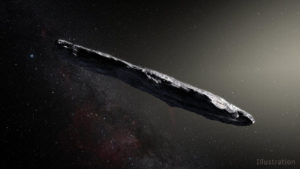
Artist’s conception of ‘Oumuamua.
The recent visit to our solar system by the interstellar object ‘Oumuamua has raised considerable controversy in the scientific community. Based on the fact that it is moving too fast to be trapped in an orbit around the Sun, ‘Oumuamua is the first object confidently identified as originating from outside our solar system. Its origin is unclear, and one likely possibility is that it is debris ejected from another planetary system. But Avi Loeb, chair of astronomy at Harvard, has proposed a more exciting but understandably controversial idea: ‘Oumuamua may be a probe from an alien civilization.
The idea’s not as crazy as it sounds — since interstellar distances take so long to cross (with current technologies, it’s at least 20 years to *our* nearest stellar neighbor), we think aliens are likely to explore using automated spacecraft rather than sending themselves.
And ‘Oumuamua did behave strangely during its short visit to our solar system. As it rounded the Sun, astronomers observed an anomalous acceleration inconsistent with the pull of the Sun’s gravity. For comets, such accelerations are common and attributed to jetting from vaporizing ice. But astronomers saw no evidence for such jetting from ‘Oumuamua. In addition, ‘Oumuamua has a funny shape, perhaps resembling a cigar, unusual but not totally impossible for a comet-like body.
Loeb has explained these anomalies by proposing that ‘Oumuamua is an alien solar sail, harnessing the radiation pressure from the Sun to navigate the cosmos. Such solar sails may be a low-cost, efficient means of plying the interstellar waters and have featured in recent technology demonstrations from the Planetary Society. If ‘Oumuamua were, indeed, a solar sail, that might explain both the anomalous acceleration and the unusual shape.

Fig. 1 from Bialy & Loeb (2019). The maximum distance a solar sail can travel L_max depends on the sail’s mass-to-area ratio, m/A, but Bialy and Loeb’s calculation suggest ‘Oumuamua could safely traverse the entire Milky Way.
One potential problem for is that, to work, a solar sail must be very light-weight and thin – the Planetary Society’s LightSail 2 spacecraft is a square almost six meters to a side, but weighing less than a bowling ball. It’s easy to imagine that such a cosmic tissue might not survive the rigors of interstellar travel. And so in a recent paper, Shmuel Bialy and Avi Loeb conduct a series of back-of-the-envelope calculations to argue that the interstellar rigors might not be so rigorous.
One of the biggest hazards for a solar sail would collisions with interstellar dust and gas – each collision could sap ‘Oumuamua’s momentum and vaporize its surface. However, Bialy and Loeb estimate that a solar-sail ‘Oumuamua could plausibly traverse tens or hundreds of kiloparsecs before such collisions would be a problem. That means ‘Oumuamua could cross the entire Milky Way before suffering a mission-ending number of collisions.
As compelling as their calculations are, my instinct (and that of most astronomers) is that ‘Oumuamua is something more mundane than an alien craft. But the conversation catalyzed by Loeb’s suggestions is probably healthy for the field of SETI, and certainly the public enthusiasm is encouraging – people love space and want desperately to find extraterrestrials.
The challenge is to keep these debates firmly scientific, to strike a balance between pushing the envelope and tearing the envelope to shreds. And the line between science and pseudo-science in the realm of alien life can be as tissue-thin as a solar sail.